| Botanical Name |
|
| Family |
Apocynaceae - The Oleander or Dogbane family. |
| Pronunciation |
pak-uh-PO-dee-um by-spin-OH-sum |
| Common Name(s) |
Afrikaans: Bobbejaankos; Kragman; Sterkman; Kamoa
|
| Plant Group |
- Succulent A plant having fleshy stems or leaves often adapted to dry conditions.
|
| Plant Size |
- Medium to Large
| Tree | 15m to 20m |
| Shrub | 2m to 3m |
| Perennial/ground cover | 60cm to 75cm |
| Bulb | 60cm to 1m |
| Succulent | 60cm to 1m |
- Medium
| Tree | 10m to 16m |
| Shrub | 1m to 2m |
| Perennial/ground cover | 40cm to 60cm |
| Bulb | 40cm to 60cm |
| Succulent | 40cm to 60cm |
|
| Position |
- Partial Shade The area is in shade for part of the day and in full sun for part of the day.
- Sun The area is in full sun for all or most of the day, all year round.
|
| General Information |
- Deciduous to Semi-deciduous In warmer areas a deciduous plant may not lose its leaves during winter at all, or may lose its leaves for a very brief period, or may only lose part of its foliage.
- Drought Tolerance: High The plant is well adapted to arid conditions; it can survive long periods of drought and high temperatures without extra water.
- Frost: Hardy The plant can withstand freezing temperatures or frost without artificial protection.
- Thorns / Spines / Prickles Thorn: A hard, woody, pointed branchlet.
Spine: A modified leaf forming a hard, sharp-pointed outgrowth.
Prickle: A small, sharp-pointed outgrowth growing from the bark of the plant.
- Water Wise Plant species originating from low rainfall regions that require less water to survive and thrive than other plant species.
|
| Specific Information |
Pachypodium bispinosum is a succulent shrublet that it has a large, tuberous stem up to 25 cm in diameter and 30+ cm in height, most of which is below ground level where it gets protection from frost and the hot rays of the sun. This swollen stem is known as a caudex and stores water, enabling the plant to survive harsh conditions and long periods of drought. The stems are interspersed with paired straight spines 10 - 20 mm long. Leaves are narrow, dark green and are scattered along the stems and clustered towards the ends of branches.
Pachypodium succulentum and Pachypodium bispinosum are the only two members of this species that are able to survive temperatures to slightly below 0ºC
For an informative description of Pachypodiums in South Africa, visit http://www.plantzafrica.com
As with most other Caudiciforms, collectors display these plants with a large proportion of the caudex raised above the ground.
|
| Ad Break |
|
| Flowers |
| Description |
bell-shaped with a dark pink throat opening out with five broadly rounded pale pink lobes
|
| Season |
- Spring to Summer Plants will seldom bloom for the entire season as given in the list, but should flower during a period within these parameters.
|
| Colour |
|
| Growth Rate |
- Very Slow Specifying growth rate can be very misleading as there is considerable variation of growth rate depending on type and species of plant, available water, supplementary feeding, mulching and general care, as well as the plants suitability and adaptability to the garden environment.
|
| Plant Uses |
- Accent or Focal Point A plant used to attract the attention because of its colour or form.
- Container Trees, shrubs and ornamental species that can adapt to growing in a restricted environment.
- Filler Either a fast growing tree or shrub used temporarily to fill in an area while the permanent plants grow to a desired size, or a plant used to fill gaps in borders or beds.
- Rock Garden An area constructed of larger rocks, arranged naturally, to emphasise the use of stones as a main element. Generally plants used do not need a lot of care.
- Suitable for smaller gardens Such plants do not have invasive root systems, remain small or controllable and can often be grown in containers.
- Wild Garden An indigenous garden planted for the benefit of wildlife and birds. Provides food, water, a variety of mini-biomes and no poisonous chemicals are used.
|
| Distribution and Habitat |
in the Eastern Cape province, in arid, stony places and in dry scrub and on rocky slopes
|
| Planting Suggestions |
Pachypodium bispinosum adapts well to xeric gardens and warm dry environments and is not suitable for cold and wet situations. Plant in very well-drained soil, water during spring and summer but very little during the dormant period. Although the soil should dry out between waterings, never allow the soil to bake dry (even during the dormant period). Be careful not to damage the brittle roots when transplanting as these plants are prone to rot. If the plant is displayed with the caudex above ground, it will need protection from frost and sunburn. The caudex will grow much faster if it is buried.
|
| Medicinal Uses |
|
| Ad Break |
|


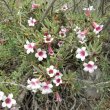
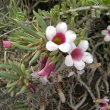
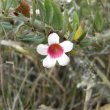
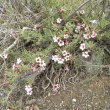
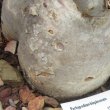
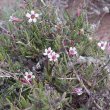


Discuss this plant
Share knowledge, ask a question or give an experience.